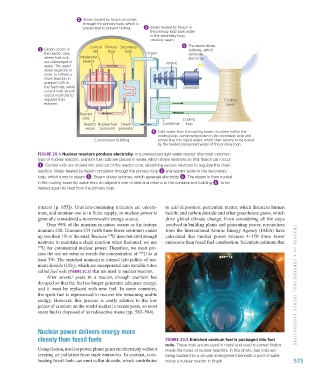Page 576 - Environment: The Science Behind the Stories
P. 576
2 Water heated by fission circulates
through the primary loop, which is
pressurized to prevent boiling. 3 Water heated by fission in
the primary loop boils water
in the secondary loop,
creating steam.
Control Primary Secondary 4 The steam drives
1 Fission occurs in turbines, which
the reactor core, rod loop loop Steam generate
where fuel rods Moderator electricity.
are submerged in (water) Turbine
water. The water
slows neutrons in
order to initiate a
chain reaction in
uranium-235 in
the fuel rods, while Generator
control rods absorb Cooling
excess neutrons to tower
regulate that Cooling
reaction. tower
Reactor
core Cooling
Reactor Nuclear fuel Steam Condenser loop
vessel (uranium) generator
5 Cold water from the cooling tower circulates within the
cooling loop, condensing steam in the secondary loop and
Containment building converting it to liquid water, which then returns to be boiled
by the heated pressurized water of the primary loop.
FIGURE 20.4 Nuclear reactors produce electricity. In a pressurized light water reactor (the most common
type of nuclear reactor), uranium fuel rods are placed in water, which slows neutrons so that fission can occur
1 . Control rods are moved into and out of the reactor core, absorbing excess neutrons to regulate the chain
reaction. Water heated by fission circulates through the primary loop 2 and warms water in the secondary
loop, which turns to steam 3 . Steam drives turbines, which generate electricity 4 . The steam is then cooled
in the cooling tower by water from an adjacent river or lake and returns to the containment building 5 , to be
heated again by heat from the primary loop.
interest [p. 655]). Uranium-containing minerals are uncom- to acid deposition; particulate matter, which threatens human
mon, and uranium ore is in finite supply, so nuclear power is health; and carbon dioxide and other greenhouse gases, which
generally considered a nonrenewable energy source. drive global climate change. Even considering all the steps
Over 99% of the uranium in nature occurs as the isotope involved in building plants and generating power, researchers
uranium-238. Uranium-235 (with three fewer neutrons) makes from the International Atomic Energy Agency (IAEA) have
238
up less than 1% of the total. Because U does not emit enough calculated that nuclear power releases 4–150 times fewer
neutrons to maintain a chain reaction when fissioned, we use emissions than fossil fuel combustion. Scientists estimate that
235 U for commercial nuclear power. Therefore, we must pro-
cess the ore we mine to enrich the concentration of U to at
235
least 3%. The enriched uranium is formed into pellets of ura-
nium dioxide (UO ), which are incorporated into metallic tubes
2
called fuel rods (FIGURE 20.5) that are used in nuclear reactors.
After several years in a reactor, enough uranium has
decayed so that the fuel no longer generates adequate energy, CHAPTER 20 • CONVENTI ON AL ENERGY ALTERN ATIVES
and it must be replaced with new fuel. In some countries,
the spent fuel is reprocessed to recover the remaining usable
energy. However, this process is costly relative to the low
prices of uranium on the world market in recent years, so most
spent fuel is disposed of as radioactive waste (pp. 582–584).
Nuclear power delivers energy more
cleanly than fossil fuels FIGURE 20.5 Enriched uranium fuel is packaged into fuel
rods. These rods are encased in metal and used to power fission
Using fission, nuclear power plants generate electricity without inside the cores of nuclear reactors. In this photo, fuel rods are
creating air pollution from stack emissions. In contrast, com- being loaded into a circular arrangement beneath a pool of water
busting fossil fuels can emit sulfur dioxide, which contributes inside a nuclear reactor in Brazil. 575
M20_WITH7428_05_SE_C20.indd 575 13/12/14 1:56 PM

